There’s a reason it’s called International Chest Day. Training for a big chest starts your lifting week off right — and sliding some weight plates on the bar is an effective, powerful way to do that. But here are two (not so) secrets for you: You can train your chest on any day you darn well please, and, this may shake some folks up, you don’t need free weights or cables to build an impressive chest.
In the quest for a strong and muscular chest, the humble push-up too often gets pushed to the side. Perform the push-up and its variations correctly, and you’re headed for a bigger chest, more relative strength, and even higher bench press numbers.
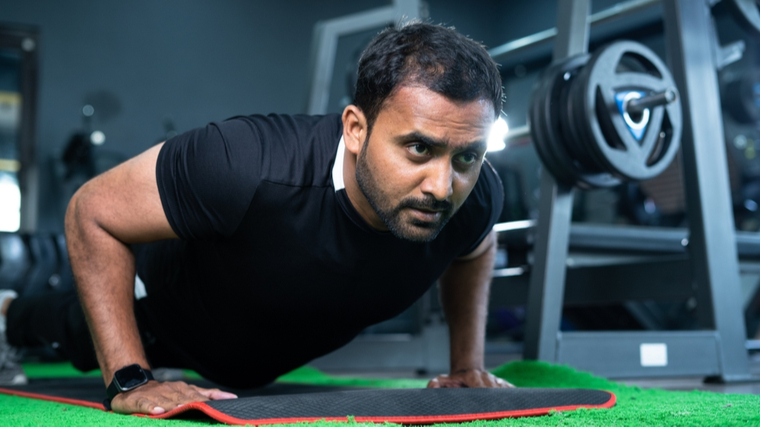
Even if you’re already ridiculously jacked, bodyweight chest exercises can help keep you at the top of your pressing game. Whether it’s impossible for you to find a weight bench on Mondays or you just want to get in a solid chest-building session in between work meetings, bodyweight chest exercises need to find their way into your training toolbox.
Best Bodyweight Chest Exercises
- Push-Up
- Parallel Bar Dip
- Chaos Push-Up
- Incline Push-Up
- Decline Push-Up
- Plyo Push-Up
- TRX® Push-Up
- Incline Plyo Push-Up
- Yoga Push-Up
- Spiderman Push-Up
- Assisted One-Arm Push-Up
- Slider Push-Ups
- Front Plank with Shoulder Tap
- Archer Push-Up
- Paused Push-Up
Push-Up
Do we need to sell you on the push-up? Probably not, but what kind of training resource would we be if we didn’t remind you that the push-up is a total-body move that trains your chest and triceps like few others?
And lest you don’t think push-ups are worth their salt, remember that you can perform push-ups for more volume and therefore stand to gain more muscle. The basic push-up has been around and performed since the dawn of training because it works — plain and simple.
Benefits of the Push-Up
- Because you’re working out with just your bodyweight, your joints won’t be under as much stress as with weighted chest exercises.
- Since they’re potentially less stressful on your body, you can really do a lot of push-ups, so you’ll accumulate more muscle-building tension and volume over time.
- Push-ups may be more accessible than bench pressing for athletes who need to be able to adjust their grip and hand positioning based on limb length and shoulder health.
How to Do the Push-Up
Get into a plank position with your hands underneath your shoulders. Keep your back flat and your feet together. Screw your palms into the ground. Hold this position to secure it. Slowly lower yourself until your chest is about an inch from the floor. Engage your core and glutes to keep your glutes and upper back in a straight line. Drive back up through the palms of your hands. Check out our push-up training program for beginners if you’re just getting started with this exercise.
Parallel Bar Dip
The dip is another bodyweight chest gem. Compared to the push-up, which has you on all fours, the dip will have you suspended from a parallel bar dip. Therefore, 100 percent of your body weight will be in play.
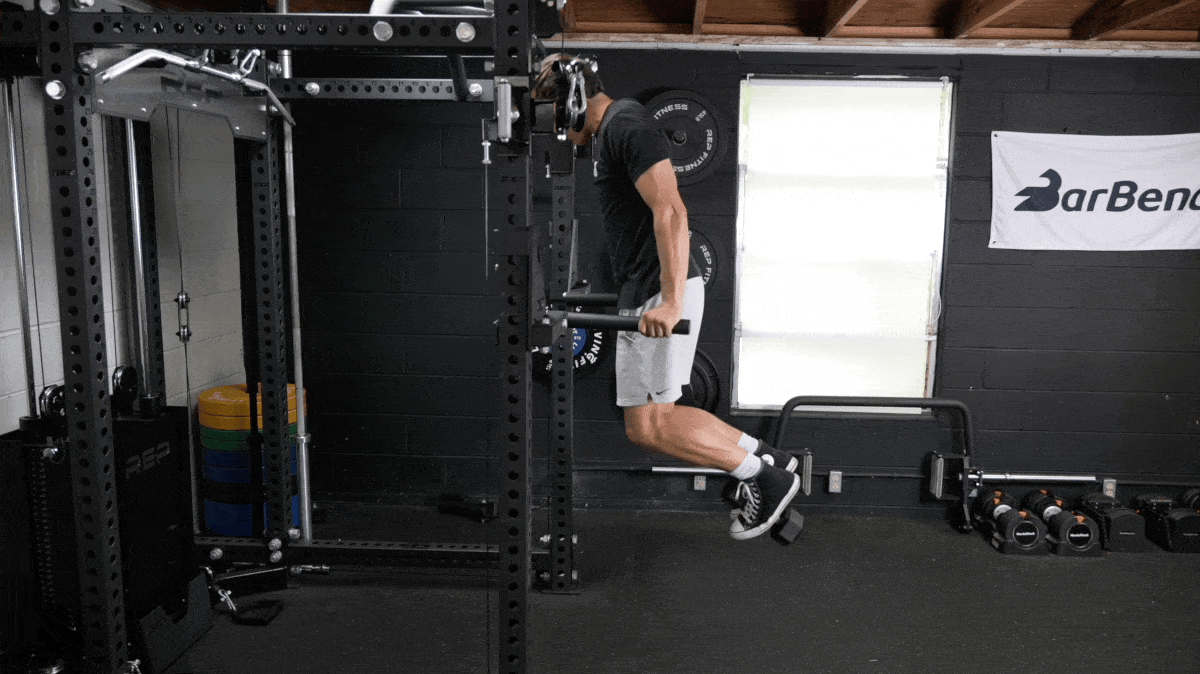
You’ll also seriously recruit your triceps, which are involved in all pressing movements and are essential for a strong bench press lockout. Working them in tandem with your chest will help strengthen your synergistic muscles in unison, making for even more strength gains.
Benefits of the Parallel Bar Dip
- You’ll strengthen your triceps and pecs — two key pressing muscles — synergistically, meaning they’ll get stronger and learn to work together in a way that will carry over to all presses.
- You will use 100 percent of your bodyweight, which is far more than what you lift during a push-up.
- This move helps improve lockout strength for key exercises like the bench press and overhead press.
How to Do the Parallel Bar Dip
Grab the dip bar firmly. Get yourself in the top of the dip position. Lock out your arms. Keep your upper back tight. Squeeze your shoulder blades together. Engage your glutes and brace your core. Angle your torso slightly forward. Allow your elbows to bend as they slightly tuck inwards towards the sides of your torso. Lower yourself down until your elbows are at about 90 degrees. Press through the handles. Bring your body back upright to the top of the dip position. Reset and repeat.
Chaos Push-Up
Heavy plates and barbells aren’t the only great chest-building tools out there. Resistance bands can help you build a bigger, stronger chest, teach you bodily control over your movements, and reinforce stability within your joints and stabilizer muscles.
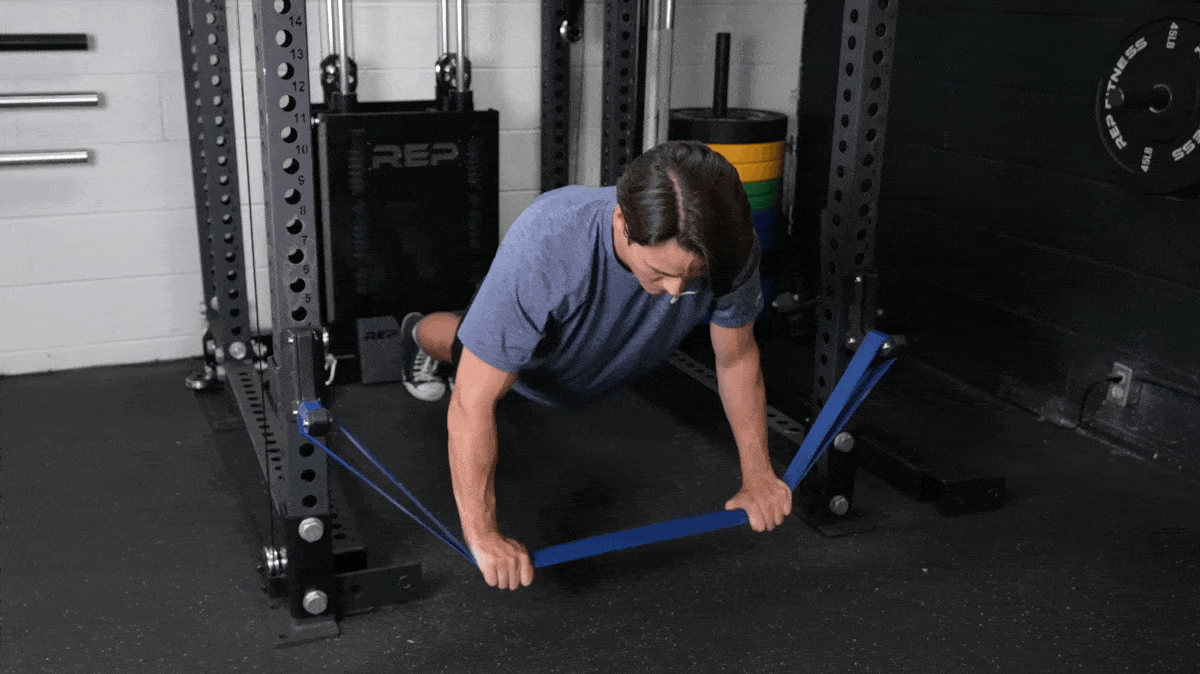
By looping a heavy band around a squat rack, you level up the standard push-up into the chaos push-up. By pushing off of an unstable resistance band, you’ll fire up all your stabilizer muscles and be forced to slow down your reps. Perform these with anything less than perfect form, and the band will give you instant feedback. Plus, the increased time under tension does wonders for your muscle-building goals.
Benefits of the Chaos Push-Up
- The instability of the chaos push-up requires — and therefore improves — rotator cuff recruitment to help you stabilize the move.
- This variation requires more core stability and control, which can help you dial in your form when you’re getting a little too comfortable repping out standard push-ups.
- Working with a resistance band increases your time under tension, which enhances your potential for muscle growth.
How to Do the Chaos Push-Up
Loop a heavy-duty band around a squat rack so it’s horizontal to you and parallel to the ground. The higher up the band, the easier the exercise. The lower the band, the harder you’ll work. Place your hands on the band at shoulder-width. Grip tightly. Bring your legs behind you. Engage your glutes and core. Lower yourself down into a push-up. Press yourself up. Reset and repeat.
Incline Push-Up
Many may consider the incline push-up an entry-level variation, but any lifter can benefit from this more inclusive variation. Performing the classic move on an incline means you lift less of your bodyweight, making it more accessible for beginners.
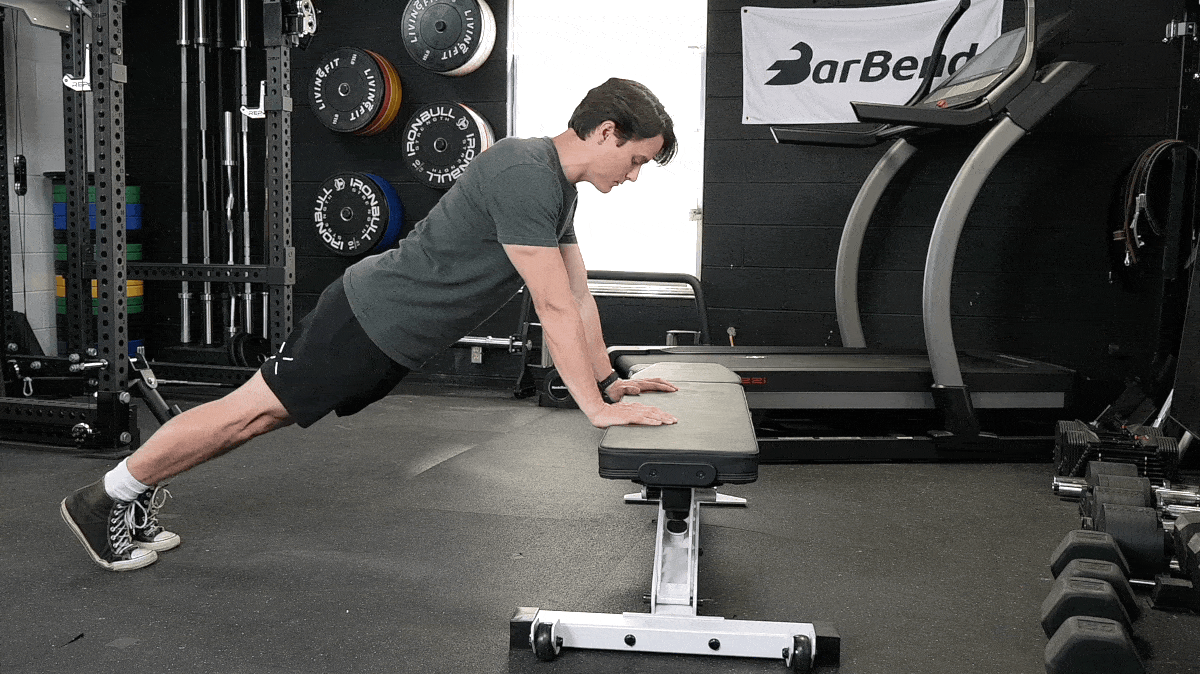
But that doesn’t mean this move is only for beginners. Lifting less of your bodyweight means you’re able to do more reps, which can increase your muscle-building stimulus. Plus, the incline push-up shifts your body’s focus to the muscle fibers in your lower chest, which can promote better overall chest development.
[RELATED: Best Lower Chest Exercises]
Benefits of the Incline Push-Up
- This variation can help beginners nail down proper form and improve core strength.
- Performing a push-up on an incline shifts some focus to the muscle fibers in a lifter’s oft-neglected lower chest.
- Because you’re moving less of your bodyweight, you’re able to do more reps to increase hypertrophy and muscular endurance.
How to Do the Incline Push-Up
Brace both hands on a bench, a stable bar (perhaps in a Smith machine), bumper plates, or a step platform. Squeeze your glutes and core to keep your upper and lower body in a line. Lower with control until your chest is just above the inclined surface. Keep your elbows at 45 degrees. Stabilize and push back up to the starting position.
Decline Push-Up
The decline push-up is also a great chest muscle-builder because it’s low impact, easy to scale, and can be performed for very high reps. By elevating your feet, you shift some focus to the fibers of your upper chest and anterior shoulders if you want to emphasize this region.

Because your feet are on a platform, the decline push-up also requires a lot of core and shoulder stability — so choose your decline carefully.
Benefits of the Decline Push-Up
- You’ll train your entire chest, with even more emphasis on your anterior shoulders because of the angle you’re working with.
- This variation will help improve your shoulder stability and core strength.
- This is a great way to level up your regular push-up if you’re looking for an added challenge.
How to Do the Decline Push-Up
Place your toes on an elevated surface behind you. Place your hands underneath your shoulders. Push back into your heels. Squeeze your core and glutes to help keep your body rigid. Lower into a push-up until your chest is just above the floor. Keep your elbows at 45 degrees. Press back up to the starting position.
Plyo Push-Up
The plyo push-up is an advanced plyometric variation where your hands leave the ground. You’ll drive up, explode your hands off the ground, and then smoothly descend into another push-up.
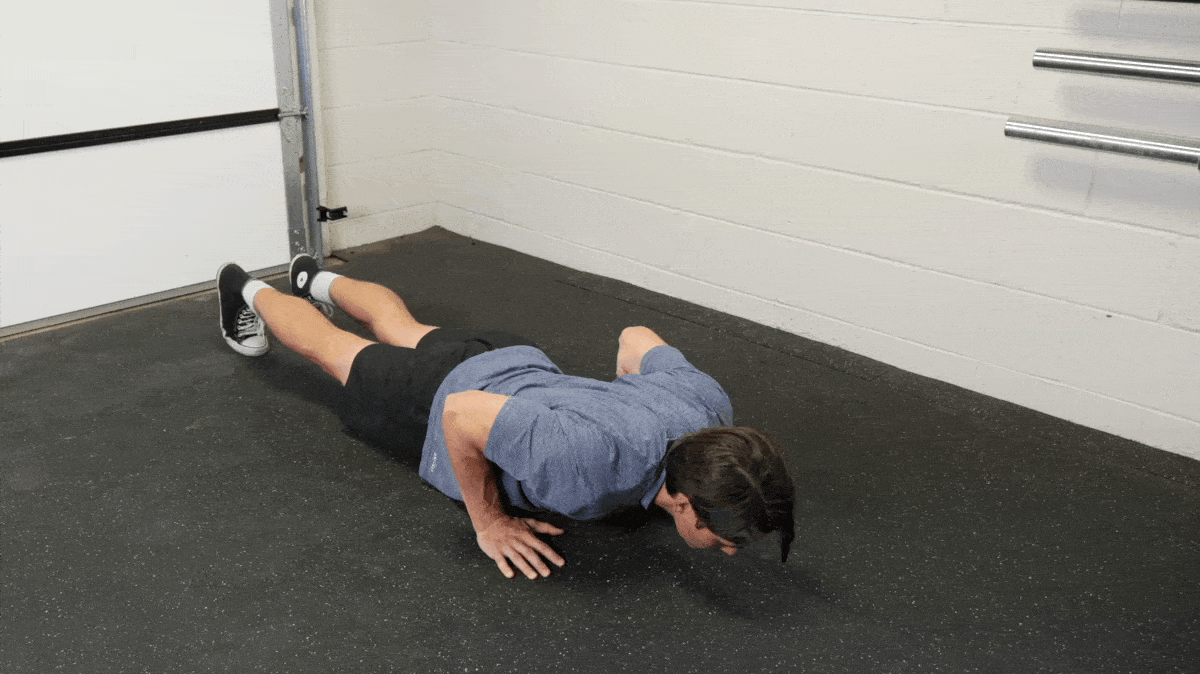
Power exercises like this train primarily the fast-twitch muscle fibers — these fibers are capable of more growth than slow-twitch fibers. When you can press lighter weight faster, it’s likely to have a positive carryover to slower but heavier exercises like the overhead press and bench press.
Benefits of the Plyo Push-Up
- Increased motor unit recruitment leads to improved power and hypertrophy.
- Explosive upper body moves can help add pounds to slower, steadier, and heavier barbell lifts.
- This variation requires a lot of quickness and coordination, which can help you gain confidence in fast, explosive lifts like the snatch and clean & jerk.
How to Do the Plyo Push-Up
Get into a push-up position with your body rigid. Lower into a push-up with your elbows at a 45-degree angle. Just before your chest touches the floor, explosively push up so that your hands leave the floor. Catch yourself on the ground with a bend in your elbows. Use that bend to lower into another push-up. Rinse and repeat.
TRX® Push-Up
Performing push-ups with a TRX can do wonders for your push-up technique. Similar to the chaos push-up, the unstable nature of the TRX will give you instant feedback if anything is amiss.
The beauty of the TRX is you can adjust your foot position to make this exercise harder (closer to the anchor point) or easier (further away). This tests your core strength and shoulder stability while training your chest muscles.
Benefits of the TRX® Push-Up
- This variation improves your pressing technique and core strength through the instability it offers.
- You can customize this move to be harder or easier by moving your feet.
- The instability of the exercise base will help strengthen your rotator cuffs.
How to Do the TRX® Push-Up
Place your hands in the TRX straps with your hands underneath shoulders. Set up your feet in your preferred position. Engage your glutes to get your body in a straight line. Slowly lower into a push-up. Keep your elbows at a 45-degree angle until your elbows are level with your torso. Pause and press back up.
Incline Plyo Push-Up
With the incline plyo push-up, you’ll be elevating your hands on a bench. This allows you to generate more power with less compressive stress on your joints. The incline will also make it easier to maintain a neutral spine position.
This is a great variation of the regular plyo push-up as you’ll be pressing less of your weight. This may allow you to squeak out a few more reps.
Benefits of the Incline Plyo Push-Up
- Compared to the standard plyo push-up, this version will place less stress on your joints.
- Because you’re pressing less body weight, this move is more accessible than the regular plyo push-up.
- You’ll be able to perform a few more reps compared to regular plyo push-ups due to the angle of movement.
How to Do the Incline Plyo Push-Up
Get into a push-up position on a weight bench. Place your hands underneath your shoulders. Maintain a solid front plank position. Lower yourself to the bench. Explosively push yourself up with your hands leaving the bench. Slightly bend your elbows on the way down to properly absorb the force. Rapidly descend into another push-up and repeat.
Yoga Push-Up
Yoga push-ups combine a push-up and downward dog yoga pose; therefore training your strength, mobility and flexibility all at the same time.
This move provide extended time under tension, compared to the standard push-up, as you change the pressing angle by transitioning to the downward dog. Pushing away from the floor in that way improves shoulder strength and thoracic mobility. Your hamstrings also get a nice stretch. This makes for a great upper body warm-up move before hitting the barbell.
Benefits of the Yoga Push-Up
- This variation provides extra time under tension for your chest and upper back.
- The transition to the downward dog position improves your shoulder stability.
- You’ll boost your thoracic mobility by dynamically shifting between your push-up and down dog.
How to Do the Yoga Push-Up
Start in a regular push-up position. Keep your body in a straight line from head to heel. Descend into a push-up with your elbows 45 degrees out from your torso. When your chest is just above the floor, rise back up. Push your hips back and upward. Tuck your tailbone back and behind you. Keep your shoulders relaxed and push them away from your ears. Transition back into the push-up position and repeat.
Spiderman Push-Up
The spiderman push-up is an advanced bodyweight chest exercise because both your upper body and core are trained in one fluid movement. You’ll need full-body coordination to complete this move effectively — not to mention immense core strength and hip mobility.
This move will increase your chest’s time under tension at the bottom of your push-up. Because you’ll be holding an isometric contraction while working your lower body and core, you’ll majorly improve your chest strength and muscle-building potential.
Benefits of the Spiderman Push-Up
- You’ll improve your core and hip strength while building chest strength.
- Staying in an isometric contraction at the bottom of your push-up provides a huge boost to your chest strength and hypertrophy potential.
- This move requires and improves total-body coordination.
How to Do the Spiderman Push-Up
Assume a push-up position with your hands slightly wider than shoulder-width apart. As you’re lowering your chest to the ground, bend your right knee and draw it toward your right forearm. Pause with this contraction while your chest hovers near the ground. Slowly bring your foot back to the starting position as you push yourself back up. Repeat with the left leg.
Assisted One-Arm Push-Up
One-arm push-ups are the gold standard of push-ups. Can’t quite beast out the full version out yet? No problem. A nice variation that gives you similar benefits as the full one-arm push-up is the one-arm assisted push-up.
You’ll use your non-working arm to assist your pushing arm by holding on slightly to an elevated surface. Your goal is to rely as little as possible on your non-working arm while your working arm absorbs most of your bodyweight.
Benefits of the Assisted One-Arm Push-Up
- This predominately unilateral move will help reduce strength imbalances between sides.
- This is a far more attainable movement than the one-arm push-up, and one of the best exercises for working up to a complete one-arm push-up.
- You’ll add more time under tension on your chest and triceps, which is great for building muscle.
How to Do the Assisted One-Arm Push-Up
Place your outstretched arm to the side of you on an elevated surface below shoulder height. Get into a push-up position with your feet wider than hip-width apart. Lower into a push-up on your working arm. Use a range of motion you can control. Push back to the starting position. Rest and repeat.
Slider Push-Up
The slider push-up is an advanced bodyweight exercise that builds strength in your arms, shoulders, and chest while building top-notch core strength. Using core sliders or even a towel you’ll be sliding one arm either forward or laterally during your push-up.
This engages the stabilizer muscles around your rib cage while increasing time under tension on your chest muscles. If you have issues with shoulder mobility, only progress with this move slowly and with caution.
Benefits of the Slider Push-Up
- This move helps you build strength in both your upper and lower body, which will help stabilize you.
- You’ll train your serratus anterior, which is an important muscle for shoulder health.
- With slider push-ups, you’ll help yourself learn one-arm push-ups.
How to Do the Slider Push-Up
Put an exercise slider under each of your hands while on your hands and knees. (You can also place your hand on a sock or towel, provided you’re on a hardwood floor.) Grip the ground with your hands. Rotate your shoulders outward to put your wrists, elbows, and shoulders in a stacked position. Take your knees off the ground. Extend your legs into a push-up position. Engage your quads, core, and glutes. Lower into a push-up on the right arm by extending the left arm in front of you. Return to the push-up position. Repeat on the opposite arm. Alternate for reps. You can also extend your arms out laterally instead of — or in addition to — out in front of you.
Front Plank with Shoulder Tap
The front plank with a shoulder tap is a full-body core exercise that trains your chest in an isometric fashion. Every time you take one hand off the ground, your whole body has to stabilize, including your chest.
Getting stronger in the front plank position will only help you do more push-ups — and craft a stronger chest. After all, a push-up is a moving plank.
Benefits of the Front Plank with Shoulder Tap
- This move trains your chest, hip flexors, abs, back, glutes, hamstrings, and quads as a unit.
- You’ll improve your anti-rotational core strength by keeping your hips and shoulders level throughout the move.
- Strengthening the front plank position helps you to be able to do more push-ups.
How to Do the Front Plank with Shoulder Tap
Begin in a front plank position. Keep your wrists under your shoulders and your feet hip-width apart. Squeeze your glutes and quads to get your spine neutral. Slowly touch your left shoulder with your right hand without rotating at your hips. Return to the starting position. Touch your right shoulder with your left hand slowly. Alternate sides for the desired amount of reps.
Archer Push-Up
The archer push-up has you performing a push-up using only one arm while using the other for support and stability. This is similar to the one-arm assisted push-up, except you are moving from side-to-side.
Performing this lateral movement trains your chest from a different angle than it is typically accustomed to. All the while, you’ll be combating pressing imbalances between sides.
Benefits of the Archer Push-Up
- You’ll strengthen and build your chest muscles from a different angle than usual.
- Archer push-ups help you prepare for one-arm push-ups.
- You’ll be moving laterally throughout this movement, which helps you address strength imbalances and muscle asymmetries.
How to Do the Archer Push-Up
Get into an all-fours with your knees, toes, and hands on the floor. Outwardly rotate your hands so your fingers are pointed away from your body. Place your arms slightly wider than shoulder-width apart. Grip the floor with your hands. Straighten your legs to get into a push-up position. Maintain a strong plank position. Pull the right side of your chest toward your right hand as you bend your right elbow. Simultaneously straighten your left arm. Return to the starting position. Repeat on the opposite side. Alternate sides for the desired repetitions.
Paused Push-Up
There’s nothing wrong with pumping out as many push-ups as possible. But if you want to feel your chest muscles working hard as soon as possible, add a pause to your proverbial arsenal.
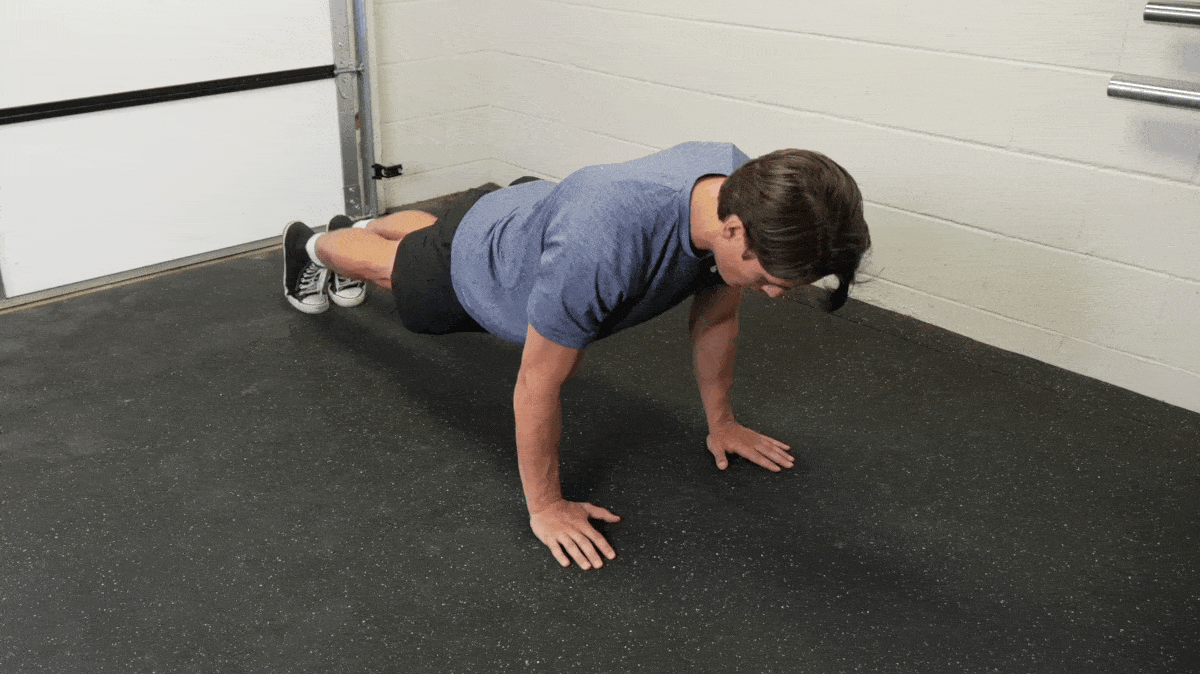
Pausing at the bottom of your push-up adds more time under tension for your chest muscles. Plus, it takes the stretch reflex out of the muscle, making you work much harder to overcome gravity. You will not be able to do as many reps, but your chest will be feeling the burn.
Benefits of the Paused Push-Up
- The pause in the bottom position puts more time under tension on your chest muscles.
- Pausing makes concentric contraction more difficult because the muscle stretch reflex is taken away.
- You’ll have to work much harder to perform fewer reps than regular push-ups, potentially making your workout more time-efficient.
How to Do the Paused Push-Up
Set up as you would for a regular push-up. Lower your chest to the ground with your arms 45 degrees out from your torso. Stop with your chest just above the ground for three to five seconds. Push back up until lockout. Reset and repeat.
Benefits of Bodyweight Chest Exercises
It’s not only about your mirror muscles. There are plenty of performance-based reasons to add bodyweight chest exercises to your routine.
Improved Shoulder Health
Your back is probably the first thing that comes to your mind when you think about your posture — which plays a big role in your shoulder health. But your chest is also a player in assisting with upright posture, as its length and strength dictate your shoulder position.
Your chest helps your upper back and shoulders to stabilize the entire shoulder joint. When training push-ups, your shoulder blades move freely. This strengthens your serratus anterior, a muscle important for shoulder health and performance.
[Read More: Best Upper Chest Exercises for Building Muscle]
It’s important to note that if your elbow angle doesn’t feel good, your shoulders might not love your push-ups, either. Make sure your form is tailored to your body’s needs in order to use push-ups to bolster — instead of inhibit — shoulder health.
Properly warm up before performing push-ups, especially more advanced variations. You also might want to opt for doing your push-ups on an incline to reduce the range of motion and potential stress on your shoulders. That way, these moves can help boost shoulder health instead of stress them out.
Better Breathing
Strengthening and lengthening your chest muscles helps to support deeper breathing through expansion and contraction of your ribcage. Your chest muscles are attached to your ribcage, which expands with every breath. If they are tight, weak, or short, it affects your ability to breathe deeply. This can quickly become an issue at the gym, particularly during conditioning or anaerobic workouts.
Improved Athletic Performance
For strength athletes who need to push heavy weight, bodyweight chest exercises can add a lot of quality volume to your pressing routine. Without all that pressure on your joints and nervous system from pushing heavy barbells, moves like dips and push-ups build your chest without adding too much extra strain. That added volume can help improve your bench press performance, even when all the weight benches are being used.
Even if you’re not a strength athlete, bodyweight chest movements can help your sports performance. As your chest is your main hugging muscle, its size and strength help tackle and fends off opponents on the football field. Plus, your chest muscles help you hit a tennis ball and throw a baseball faster and harder.
Increased Volume And Muscle Growth
The beauty of bodyweight exercises is that they are easier on your body than weighted movements. This means you can add more volume and recover faster. Therefore, you can train these moves more frequently for better muscle-building potential.
Adding volume to your pressing routine is especially useful and effective. Your chest can often handle higher training frequency than, for example, your lower body. (1) That’s a recipe for bench pressing success if you add relatively low-stress push-ups to fill out your pushing program.
Improve Your Relative Strength
Relative strength is how much weight you can lift in comparison with your bodyweight. By moving your bodyweight for more reps, volume, and time under tension, you’ll increase your relative strength. Being able to manipulate your own bodyweight can improve your confidence and performance with and without the barbell.
Anatomy of the Chest
Your chest muscles run at different angles across the top front of your torso. Understanding what they are and how they work is important for building a stronger chest. Here’s a breakdown of the major chest muscles.
Pectoralis Major
The chest is made up of two muscles, the pectoralis major and the pectoralis minor muscle. The pectoralis major is a large superficial (near the surface) muscle. It’s located on the front surface of your rib cage.
[Read More: The Best Quad Exercises and Quad Workouts for Muscle Gain]
The pectoralis major has two major heads — the clavicular head which is in the upper region of your chest, and the sternal head in the middle to lower region of your chest. The clavicular part of your chest helps to flex your extended arm up to 90 degrees, while the sternal part assists in extending your flexed arm by pulling it down.
Pectoralis Minor
The pectoralis minor is a superficial muscle on the anterior part of your chest, located deep to (underneath) your pectoralis major muscle. This muscle helps you pull your shoulder blades down, which is hugely important for maintaining your form in so many exercises. The pec minor also moves your rib cage such that you’re able to take deep, steady breaths.
How to Program Bodyweight Chest Exercises
As your chest is the physically largest upper body pressing muscle you have, you can train it more often than your shoulders or arms. Plus, training your chest with bodyweight moves will generally not eat into your recovery compared to weighted pressing exercises. Integrating these moves into your program can be a great way to supplement your bigger presses.
For Strength
Beginning lifters are more likely to experience huge strength gains from performing push-ups than advanced trainees. Folks who are new to push-ups and other bodyweight moves will first want to find out how many reps they can do before hitting their limit. Instead of training all the way to failure to promote strength, beginners might want to perform three to four sets of two or three reps shy of failure.
For advanced lifters looking to build strength with just their bodyweight, you might want to opt for more intense variations like the spiderman push-up, archer push-up, or the assisted arm push-ups. Aim for a rep or two shy of failure. You can also perform push-ups after weighted pressing exercises to really overload your chest muscles for strength purposes.
For Building Muscle
When performing push-up variations for muscle, the focus here will be increasing time under tension, your range of motion, and varying your angles for total muscle development. For example, archer push-ups and decline push-ups both expand your range of motion, pressing angles, and force your muscles to endure tension for a longer period than normal.
Use those techniques to train to or near failure when you want to build muscle with just your bodyweight. Try for four sets approaching failure with moves that put your muscles under extra tension for longer periods of time.
For Warm-Ups
If you’re experienced with them, bodyweight push-ups or even dips can be excellent choices for warming up your upper body. The goal here is not to exhaust yourself, but to get yourself ready for heavy loads ahead. Performing one to two sets of eight to 12 reps of the front plank with shoulder tap, yoga push-ups, or regular push-ups works well as part of your dynamic warm-up.
That said, you’ll often want to spend at least a few brief moments getting your wrists and shoulders ready for the rigors of the push-up. Try flowing through some wrist circles, cat-cows, wall slides, and scapular push-ups before sinking into push-up land.
Go Push Yourself
When you’re looking to elevate your chest training without loading up the barbell, there are plenty of bodyweight chest exercises to choose from. You won’t be settling for less — you’ll be maximizing your own body’s potential for building strength without equipment. Plus, you’ll never be at a loss for what to do when the Monday benching crowd descends on the weight benches.
References
- Candow, Darren G.; Burke, Darren G. Effect of Short-term Equal-volume Resistance Training with Different Workout Frequency on Muscle Mass and Strength in Untrained Men and Women, Journal of Strength and Conditioning Research: February 2007 – Volume 21 – Issue 1 – p 204-207.
Featured Image: WESTOCK PRODUCTIONS / Shutterstock